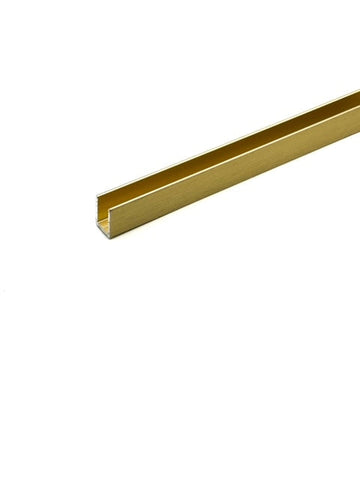
U-channels for glass are essential structural and aesthetic components in modern architectural glazing systems. These channels, often made of aluminium or stainless steel, serve to secure glass panels in place without the need for bulky frames or visible clamps. Whether you're installing a frameless shower, glass balustrade, or partition wall, U-channels provide the sleek finish and stable foundation that define high-quality glass installations.
From glass shower enclosures to commercial office partitions, U-channels allow for minimal hardware visibility while providing exceptional support. This article explores the various types of U-channels, their practical uses, and key installation tips, making it a valuable guide for homeowners, contractors, and interior designers looking to integrate glass elegantly and safely into any space.

What Are U-Channels for Glass?
U-channels are metal profiles—typically aluminium or stainless steel—shaped like the letter "U" to accommodate and secure the edges of glass panels. Designed to support vertical or horizontal glass installations, these channels are a staple in frameless designs where minimalism and structural integrity must co-exist.
At Quality Glass Fittings Ltd, U-channels are available in multiple variants:
-
Standard U-channels for general applications
-
Slim U-channels for a less obtrusive visual profile
-
Heavy-duty U-channels for supporting thicker or heavier glass
-
Dry glaze U-channels, which eliminate the need for wet silicone sealing
U-channels typically support 8mm, 10mm, and 12mm toughened glass panels and are offered in different finishes such as brushed stainless steel, matte black, and polished chrome—ensuring seamless integration with other glass hardware like clamps, hinges, and handles.
These channels are often paired with rubber gaskets or glass packers to absorb shock, enhance grip, and prevent direct metal-to-glass contact. The result is a stable, clean-lined, and waterproof installation.
Types of U-Channels for Glass
Understanding the different types of U-channels helps ensure the right product is selected for each project. Each type offers specific advantages based on the application, glass thickness, and design intent.
1. Standard U-Channels
Standard U-channels are the most commonly used and suit a wide range of applications, including frameless shower enclosures, balustrades, and partitions. These typically accommodate 10mm or 12mm glass and come in various finishes.
2. Slim U-Channels
Slim U-channels have narrower flanges and base width, making them ideal for minimalist designs. While they offer less structural grip than heavy-duty models, they provide a more elegant appearance with reduced visual interference.
3. Heavy-Duty U-Channels
Designed for larger or thicker glass panels (up to 15mm or laminated units), heavy-duty channels provide maximum strength and are commonly used in commercial balustrade systems or high-impact zones.
4. Dry Glaze U-Channels
These channels use pressure plates and internal rubber gaskets rather than wet silicone, simplifying installation and allowing easy panel adjustments. Ideal for projects requiring precision and reduced curing time.
5. Base U-Channels
Base U-channels are used specifically at floor or base levels to mount balustrade panels or partitions. They may be recessed or surface-mounted, depending on design requirements.
6. Custom-Finish U-Channels
In modern interior design, custom-finished channels—like matte black or brushed brass—are increasingly preferred to match other fixtures in frameless shower fittings or office dividers.

Common Uses of U-Channels in Glazing Projects
U-channels are incredibly versatile. Here are some of their most popular applications:
Frameless Showers
U-channels secure the fixed glass panels in shower enclosures, offering a cleaner and more minimalistic alternative to bulky profiles. When paired with hinges and seal strips, they contribute to a watertight, frameless solution.
Glass Balustrades
U-channels are often mounted on floors, stairs, or balconies to hold glass balustrade panels in place. Their strength and reliability make them suitable for both interior and exterior use.
Partition Walls
In commercial spaces and open-plan homes, U-channels enable sleek and secure installation of glass partitions, offering sound separation without compromising on light or aesthetics.
Shopfronts and Displays
Retail environments rely on U-channels for transparent yet secure mounting of display panels or protective glass walls.
Glass Doors and Entrances
U-channels are used at the base or top of frameless glass doors to stabilize movement and integrate with accessories like patch fittings and floor springs.
Installation Tips for U-Channels in Glass Projects
Installing U-channels requires accuracy, proper sealing, and awareness of the surrounding conditions. Here are some expert tips:
1. Prepare the Surface
Ensure the installation surface is level, clean, and structurally sound. Use spirit levels and measuring tools to check alignment.
2. Choose the Right Gaskets
Always use rubber gaskets or glass packers inside the channel. They prevent direct contact between metal and glass and help distribute load evenly.
3. Dry Fit Before Fixing
Before applying adhesive or screws, dry-fit the channel and glass to verify alignment, edge clearance, and fit.
4. Apply Adhesive Carefully
If using silicone, apply it evenly inside the U-channel before inserting the glass. For dry glaze U-channels, no sealant is required—just insert the gasket and tighten pressure plates.
5. Secure Evenly
Use countersunk screws or anchors that match the installation surface. Space them consistently (every 200–300 mm) to avoid bowing.
6. Allow for Expansion
Leave minor gaps at the ends of long channels to accommodate thermal expansion and prevent buckling over time.
7. Seal Edges Properly
Apply clear silicone around the outer edges of the glass to enhance waterproofing and prevent dust ingress—particularly important for shower enclosures.
8. Finish with Style
Use matching end caps or polish the visible edges of the U-channel for a professional look. Match the finish to your shower hinges, handles, or brackets for cohesive design.
Comparison Table of U-Channel Types
| U-Channel Type | Best For | Glass Thickness | Key Features |
|---|---|---|---|
| Standard U-Channel | General use in showers, partitions | 8mm – 12mm | Versatile, cost-effective, easy to install |
| Slim U-Channel | Minimalist interior designs | 8mm – 10mm | Low profile, clean look |
| Heavy-Duty U-Channel | Balustrades, thick/large panels | 12mm – 15mm+ | Reinforced strength, wide base |
| Dry Glaze U-Channel | Precise, quick installs | 8mm – 12mm | No silicone needed, adjustable fit |
| Base U-Channel | Floor-level mounting | 10mm – 12mm | Recessed or surface-mounted options |
Maintenance Tips for U-Channels in Glass Installations
Ensuring the longevity and appearance of your U-channels for glass requires periodic maintenance, especially in high-moisture environments like bathrooms and exterior balustrades. These channels, while structurally durable, can accumulate grime, experience surface wear, or develop corrosion if neglected over time—particularly when made from untreated metals or installed without proper sealing.
Begin by regularly cleaning the visible portions of the U-channel using a non-abrasive cloth and mild soap solution. Avoid acidic or chlorine-based cleaners that may damage protective coatings on stainless steel or aluminium finishes. For installations in frameless showers, where exposure to water and soap residue is constant, it's advisable to rinse and dry the channels weekly to prevent limescale or mold buildup.
Check the integrity of the rubber gaskets or glass packers within the U-channel, as they serve a vital function in cushioning the glass and preventing metal contact. Over time, these internal components can harden or degrade, compromising grip and safety. Replacement is generally straightforward and should be carried out during periodic inspections.
Inspect the channel alignment and glass positioning every few months. Loose channels, especially in base-mounted applications like glass balustrades, can shift due to thermal expansion or physical impact. If the U-channel was secured using countersunk screws, ensure the fixings remain tight and corrosion-free.
For exterior installations, such as balcony balustrades or garden partitions, select U-channels with anodized or marine-grade finishes to resist UV and weathering effects. Applying a thin layer of protective wax or anti-corrosion spray annually can also extend the channel’s life.
Ultimately, regular inspection and simple care practices not only preserve the aesthetic value of glass hardware but also ensure continued safety and performance across all U-channel installations.

How to Select the Right U-Channel for Your Project
Choosing the right U-channel for glass is a critical decision that affects both the performance and appearance of your installation. With multiple types available—ranging from standard to heavy-duty, slim, and dry glaze U-channels—understanding your project requirements is essential for making an informed choice.
Start by determining the glass thickness. Most U-channels are designed for 8mm, 10mm, or 12mm glass, but thicker laminated units may require heavy-duty profiles. Using an ill-fitting channel compromises both grip and aesthetics, so always match the product spec to your glass panel dimensions.
Consider the environment where the channel will be installed. For frameless shower enclosures, select U-channels that resist moisture and accommodate waterproofing features like seal strips. Stainless steel or anodized aluminium are ideal materials for wet areas. In contrast, exterior applications—like glass balustrades—demand high-load capacity and UV resistance, making heavy-duty or base U-channels the best choice.
Aesthetics also play a vital role. If your design vision emphasizes minimalism, opt for slim U-channels with clean lines. Available finishes such as matte black, brushed stainless steel, or chrome can be coordinated with other elements like shower hinges, handles, or wall brackets for a cohesive look.
Functionality is another key factor. If you prefer a faster, cleaner installation with adjustable positioning, dry glaze U-channels are a smart choice. These require no silicone, reducing mess and allowing for post-installation tweaks.
Finally, always purchase from reputable suppliers—like Quality Glass Fittings Ltd—that provide product specifications, installation guides, and quality guarantees. Selecting the right U-channel ensures not only visual harmony but also structural integrity and user safety, regardless of the setting.

